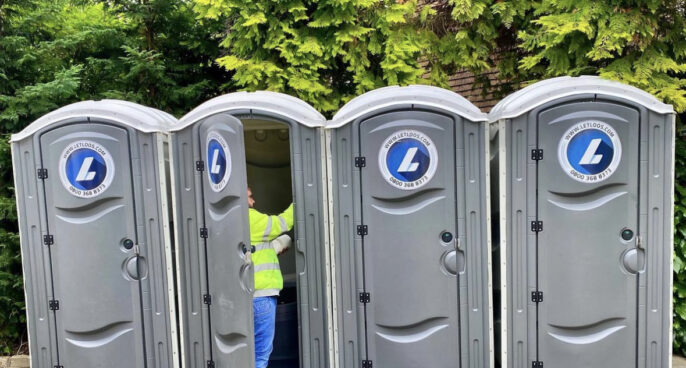- Portable Toilets Guide
- Portable toilet: What is it and how does it work?
- Types of toilets: What is the right choice for you?
- How much does it cost to hire a portable toilet?
- Portable toilet requirements and regulations
- How many portable toilets do I need for my event?
- How to clean a portable toilet? A complete guide
- How to empty portable toilets?
How to clean a portable toilet? A complete guide

It is essential to know how to clean a portable toilet. These facilities must be cleaned to a high standard before, during, and after an event.
Why? Regular cleaning will keep portable toilets as hygienic as possible. This is vital if they are used by large numbers of people, such as festival audiences.
This article will talk you through how to clean a portable toilet. It’s sensible to use a licensed sanitation company to empty your portable toilets. A company like LetLoos can manage the emptying and maintenance of portable toilets. We can also help with other services like tank emptying.
How often should portable toilets be cleaned?
According to the Health and Safety Executive, portable toilets ‘need regular cleaning.’ Chemical portable toilets should usually be cleaned once a week.
That said, both the work itself and the work site may impact how often portable toilets need cleaning. They might even need daily cleaning if workers are exposed to intense dirt. That said, it’s standard for most sanitation companies to clean portable toilets once a week.
The supplies needed for cleaning
Thankfully, it’s easy once you know how to clean a portable toilet. A weekly clean is usually included by professional sanitation companies.
If you have a portable toilet you want to clean yourself, you will need a number of supplies. These are:
- Anti-bacterial spray
- Anti-odour spray and anti-odour toilet fluid
- Chemical toilet deoderiser (also known as ‘blues’)
- Hot wash (high pressure)
- Waste suction machine (vacuum) and tank for the effluent
- Chemical fluid
You should also have replacement consumables as well as the supplies to empty and clean the toilet. These can include:
- Soap or hand sanitiser
- Toilet paper
You should only ever clean a portable toilet whilst wearing full PPE. This is essential to ensure that you maintain your own hygiene and safety throughout.
Cleaning the portable toilet during an event
Whether it’s for construction or an event, it’s essential to know how to clean the facilities. A professional company like LetLoos will send a tanker around to your facilities. This is important for both the emptying and cleaning process.
This tanker carries a waste tank that can hold anything from 500 to 4000 gallons of waste effluent. A vacuum is used to hose this up into the tank. We then transport the waste to a Thames Water treatment plant for processing.
Before waste transportation, there are some cleaning steps to be aware of…
How to clean a portable toilet during an event?
Once you have emptied the facilities, it’s important to know how to clean a portable toilet.
Most portable toilets are made of HDPE (High-Density Polyethylene). This makes them easy to clean.
- You need to clean inside the toilet to prevent the development of bacteria and germs. Ensure that you are wearing your PPE.
- Then, use your high-pressure hot wash and anti-bacterial spray to clean out the toilet bowl.
- You will then need to ‘charge’ your portable toilet. This means refilling the holding tank with fresh water and a chemical deodouriser.
- Next, you should deodourise the toilet and sanitise all surfaces.
- It’s also worth checking whether anything is broken. This is a particularly important step to take during an event. It ensures that the portable toilets are working as they should.
Cleaning the portable toilet after the event
It’s not just during an event when portable toilets need cleaning. They should also be cleaned after each event to keep them in tip-top shape for their next use. Here’s how…
Step 1. Pump
A sanitation company will use a vacuum-like machine to remove the waste effluent. This is stored in a tank and transported to an authorised sewage treatment plant.
Step 2. Clean
Take care to wear PPE when you are cleaning a portable toilet. But how do you clean a portable toilet? First, use the high-pressure hot wash to clean the toilet bowl. The most important step after emptying a portable toilet is replacing the waste tank’s water. You can then ‘charge’ the facility with a chemical deodouriser. This removes odours and helps to break down waste.
Step 3. Sanitise
Use an anti-odour and anti-bacterial spray to clean the high-touch surfaces of the toilet. This will help eliminate germs and bacteria in order to keep the facilities hygienic. You may also want to spray and scrub the walls, floors, and door handles.
Step 4. Restock
Take care that all consumables are replaced and ready for ongoing use. This includes toilet paper, paper towels, and hand soap.
Additional tips for cleaning
It’s important to ensure that facilities are well stocked, cleaned, and odourless. This can make a real difference in people’s experience of an event. It’s also a legal requirement to keep toilets hygienic on construction sites.
Chemicals used in portable toilet hygiene
Chemical deodourisers are essential when cleaning a portable toilet. These are usually dyed blue and help to break down any chemicals in the waste, as well as help with any odours. They come in liquid, packet, and ‘puck’ format. They also have a variety of scents and come in different concentrations.
There are low-chemical ways of sanitising and removing toilet odours, including white vinegar. However, they are less effective. Especially for freestanding portable toilets used by large numbers of people.
Conclusion
Knowing how to clean a portable toilet is vital to keeping facilities hygienic.
LetLoos provides a range of portable toilets across London, Essex, and Liverpool. We manage installation, removal, and maintenance with regular cleaning and emptying services. We’re also regulated and licensed by the Environment Agency to remove waste safely.
Order online or call us today – if you order before 12pm, you are guaranteed next-day delivery.

